CE–MS-MS for the Identification of Chemical Warfare Agent Degradation Products
LCGC North America
With the threat of terrorism growing, the development of analytical techniques for the detection and identification of chemical warfare agent defradation products has increased. Capillary electrophoresis (CE) presents interesting features for this application.
The different conflicts of the 20th century were marked by the use of chemical weapons. Therefore, the Chemical Weapons Convention (CWC) was signed in 1993 and came into force in 1997 to prohibit the development, production, stockpiling, and use of chemical warfare agents (1). But today, the use of chemical weapons by terrorist organizations represents a great threat. Thus, the development of analytical techniques for the detection and identification of chemical warfare agents has become essential.
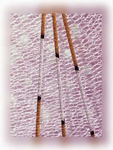
Chemical weapons are divided into four groups: vesicant (mustard gas), nerve (tabun, sarin, soman, VX, and so forth), blood (hydrogen cyanide), and incapacitating agents. Nerve agents, which are the most lethal chemicals, generally are hydrolyzed over time to first produce alkyl alkylphosphonic acids and then alkylphosphonic acids (Figure 1a) that can be used to identify the present nerve agent. Gas chromatography (GC) has been used widely for the detection of nerve agents but the analysis of their degradation products, which are less volatile and more polar, requires a time-consuming chemical derivatization (2). Liquid chromatography (LC) avoids the derivatization of the degradation products but very polar compounds generally are separated with more difficulty in the most commonly used reversed-phase mode.
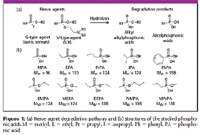
Figure 1
Capillary electrophoresis (CE) represents an interesting alternative technique for the analysis of nerve agent degradation products because CE intrinsically allows the separation of charged or polar species. Moreover, CE is known to provide high separation efficiency thanks to the flat profile of the electroosmotic flow through the capillary. Sample consumption is very limited with typical sample injection volumes between 1 and 20 nL. Therefore, CE with indirect UV detection has been used successfully for the separation of phosphonic acids (3–10).
The major drawback of CE is the limited sensitivity achieved with the commonly used UV detection. This is due to the very low injected sample amount and to the small inner diameter of the capillary (25–100 μm), representing a very short optical pathlength for the UV detection. Different electrophoretic preconcentration techniques can be employed to enhance sensitivity, such as field-amplified sample stacking (FASS), transient isotachophoresis (tITP), or sweeping (11). More sensitive detection techniques also can be used, such as laser-induced fluorescence (LIF), requiring the derivatization of the analytes or mass spectrometry (MS). CE–MS is particularly interesting thanks to the powerful identification and structural characterization capabilities of MS.
The great potential of CE–MS has encouraged the development of CE–MS interfaces most commonly involving the use of electrospray ionization (ESI) sources. Liquid junction CE–MS interfaces (Figure 2a) were developed in 1988 (12) but presented drawbacks such as peak broadening. Sheath liquid coaxial interfaces (Figure 2b) were developed in 1987 (13) and are now the most used because they are easy to use and commercially available. Sheath liquid is required for the electric contact and the formation of a stable electrospray, the CE flow-rate being by far too low, but it causes partial dilution of the analytes reducing the sensitivity. To avoid this dilution, sheathless CE–MS interfaces have been developed to allow the use of nanospray ionization sources that are compatible with the low CE flow rates and are known to provide better ionization efficiencies. The major difficulty is the establishment of the electric contact that can be ensured by an in-capillary electrode (Figure 2c) (14) or by a gold-coated nanospray tip (Figure 2d) (15). Moreover, sheathless interfaces generally have a limited life (less than 1 h), but several groups are working on their life enhancement (16). Finally, CE–MS interfaces also have been developed for microsystems including a CE separation and an ESI emitter (17) or for CE-matrix-assisted laser desorption ionization (MALDI) coupling (18).
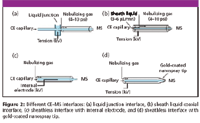
Figure 2
Despite this growing interest in CE–MS, only Kostiainen and colleagues (19) and Mercier and colleagues (20) have reported the use of this technique for the identification of phosphonic acids in deionized or tap water. During the present work, a CE–MS method was developed for the detection and identification of phosphonic acids in deionized water and soil extracts. The selectivity and identification capabilities of CE–MS-MS were evaluated by introducing several isomeric analytes (Figure 1b) in the sample. Finally, field-amplified sample stacking was carried out for sensitivity enhancement in low-conductivity matrices.
Experimental
Chemicals: The structures of the studied phosphonic acids are presented in Figure 1b. PrMPA, MPrPA, EEPA, EMPA, MEPA, and IPA were produced at the Centre d'Etudes du Bouchet, Vert-le-Petit, France, at > 99% purity (31P NMR). MPA, EPA, PrPA and PhPA were purchased from Aldrich (St Quentin Fallavier, France).
Electrolyte: The separation electrolyte was composed of 15 mM ammonium formate (Fluka, Buchs, Switzerland) adjusted to pH 8.8 with 25 % ammonia solution (Merck, Darmstadt, Germany). Deionized water used throughout was obtained from an alpha-Q system (Millipore, St Quentin en Yvelines, France). Electrolytes were filtered through a 0.2-μm PVDF membrane filter (Pall Life Sciences, East Hills, New York) before use.
Apparatus: CE separations were performed with a HP3D CE system (Agilent Technologies, Waldbronn, Germany) in 85 cm × 50 μm i.d. bare fused-silica capillaries (Agilent Technologies). Polyimide coating was removed from the outlet of the capillary (1 cm) to promote the formation of a stable electrospray. Analytes were injected hydrodynamically (5 mbar, 10 s), the separation voltage was set to + 20 kV, and the temperature to 22 °C. Between runs, capillaries were rinsed with electrolyte for 3 min.
An Esquire 3000 ion-trap mass spectrometer (Bruker, Bremen, Germany) equipped with an orthogonal ESI source was used in the negative ionization mode. Nitrogen was used as nebulizing gas (7 psi) and drying gas (200 °C, 5 L/min). ESI source voltages were as follows: spray needle at +3.5 kV, endplate offset at -500 V, capillary exit offset at -40 V, skimmer 1 at -20 V, skimmer 2 at -10 V, low mass cut-off at 50 Th. Ion accumulation time was set automatically with ion charge control (ICC) with a target of 10,000 to avoid space-charge effects. The analytical scan range for mass spectra was m/z 50 Th–500 Th. A sheath liquid coaxial interface (Agilent Technologies, Palo Alto, California) was used for CE–MS coupling. The sheath liquid composed of 75:25:2 (v/v/v) methanol–water–ammonium hydroxide mixture was delivered at 4 μL/min by a syringe pump (Cole-Parmer, Vernon Hills, Illinois).
Soil sample treatment: Soil samples were spiked with the analytes at 5 μg/g and subjected to pressure-assisted solvent extraction with water at 150 bar and 100 °C (14) in a Dionex ASE 200 instrument (Jouy-en-Josas, France). Soil extracts were next percolated through a cation-exchange cartridge (AG50WX8 resin, BioRad Laboratories, Marnes-la-Coquette, France), then concentrated 20-fold by partial solvent evaporation and finally filtered through a 0.45-μm nylon membrane filter before analysis.
Results and Discussion
Optimization of analytical conditions: A sample composed of alkylphosphonic acids MPA (Mw = 96), EPA (Mw = 110), PrPA (Mw = 124), and PhPA (Mw = 158) diluted in a 1:1 (v/v) methanol–water mixture at 1 μg/mL was analyzed by direct introduction in the mass spectrometer to optimize the source and ion trapping conditions in the negative ionization mode, providing the best responses of these analytes. The corresponding MS spectrum reported in Figure 3 showed that, as already observed by Kostiainien and colleagues (19), the abundance of the pseudomolecular ions corresponding to the analytes decreased with the number of carbons in the alkyl chain due to a decreasing ionization efficiency.
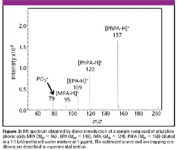
Figure 3
Nebulization gas pressure was optimized during CE–MS experiments because of the suction effect influencing the migration times and resolution. The sheath liquid composition and flow-rate strongly affect sensitivity. Different solvent mixtures (acetonitrile, methanol, isopropanol, and water) were tested and best signal-to-noise ratios were obtained with a 3:1 (v/v) methanol–water mixture containing 2% ammonium hydroxide to favor the deprotonation of the analytes improving the pseudomolecular ion abundances. A flow rate of 4 μL/min provided the best compromise between the formation of a stable spray and an acceptable dilution of the analytes.
The separation electrolyte is an essential parameter for CE analysis. Its pH determines the ionization degree of the analytes, which influences their electrophoretic mobilities and consequently, can affect the selectivity strongly. We demonstrated in a previous work (22) with CE–UV experiments that a pH 8.8 electrolyte provided a baseline separation of all alkylphosphonic acids, and particularly the IPA and PrPA isomers due to their different acidity constants inducing different ionization degrees. The electrolyte pH also determines the ionization of the silanol groups of the capillary wall, which controls the electroosmotic flow and, hence, the analysis time. The electrophoretic mobility of the electrolyte co-ion is also very important because it influences peak shape. However, CE–MS requires the use of volatile electrolyte co-ions (carbonate, acetate, or formate), thus reducing the choice for electrolyte species. The final electrolyte composition for this work was 15 mM ammonium formate adjusted to pH 8.8 with 25% ammonium hydroxide.
CE–MS-MS analysis of soil extracts: A local soil sample spiked with the 10 analytes (Figure 1b) at a concentration of 5 μg/g was subjected to pressure-assisted solvent extraction, then percolated through a cation exchange cartridge and next concentrated by partial solvent evaporation by a factor of 20 (see conditions described in experimental section). The obtained aqueous soil extract finally was analyzed by CE–MS in the optimized conditions described previously.
The obtained CE–MS electropherogram (Figure 4a) displayed few interfering species from the soil matrix. Contrary to the alkylphosphonic acids that were all separated by CE, the isomeric alkyl alkylphosphonic acids were not separated because of their very close acidity constants, inducing very close charge states. CE–MS-MS experiments were then carried out and revealed the formation of three fragment ions at m/z 109, m/z 105, and m/z 95 from the precursor ion m/z 137 corresponding to the first peak (EEPA, PrMPA, and MPrPA) and the formation of two fragment ions at m/z 91 and m/z 95 from the precursor ion m/z 123 corresponding to the second peak (MEPA and EMPA) (Figure 4b). The detailed study of the fragmentations of each isomeric alkyl alkylphosphonic acid was realized by direct introduction and reported previously (18). This allowed us to specifically attribute the fragment ions m/z 109, m/z 105, and m/z 95 observed from the precursor ion m/z 137 to EEPA, PrMPA, and MPrPA, respectively. In the same way, the fragment ions m/z 91 and m/z 95 observed from the precursor ion m/z 123 corresponded to EMPA and MEPA, respectively. Finally, CE–MS-MS experiments provided an unambiguous identification of each comigrating isomeric alkyl alkylphosphonic acid in soil extracts without interference from soil ions, illustrating the great capabilities of MS for identification. On the other hand, CE separation was mandatory for the identification of isomeric alkylphosphonic acids, which led to the same fragment ion and could not be differentiated by MS-MS.

Figure 4
Sensitivity enhancement in spiked deionized water: All analytes were detected at 5 μg/g in spiked soil samples thanks to the concentration step of the extraction treatment. Nevertheless, in deionized water, the smallest analytes were hardly detected under a concentration of 50 μg/mL (Figure 5a). The sensitivity was first limited by the decreasing ionization efficiency with the size of the analyte, but also by the very low injected sample amount. Indeed, in the absence of stacking, the maximum injection volume is 1–2% of the capillary volume to avoid resolution loss and peak shape deterioration. Different electrophoretic techniques can be carried out for in-capillary sample preconcentration (11). The simplest one is field amplified sample stacking (FASS) (23,24), which is achieved by using a separation electrolyte of higher conductivity than the sample solution. This provides a lower electric field in the electrolyte zone than in the sample zone (E = J/K). Consequently, the analytes slow down when they reach the boundary between the low-conductivity sample zone and the high-conductivity electrolyte zone. The analytes are thus concentrated into a narrow zone at this boundary, authorizing the injection of larger sample volumes. As a proof of feasibility, a sample composed of deionized water spiked with the analytes at 5 μg/mL was injected hydrodynamically at 50 mbar for 80 s, which represents an eightfold increase in sample volume (5% of the capillary volume) as compared with previous standard injection conditions. Injection volumes as high as 80 s (until 150 s) were tested but did not provide better peak heights. The obtained electropherogram (Figure 5b) showed that all analytes were stacked perfectly without any loss of resolution and detected at the 5 μg/mL level, demonstrating an eightfold sensitivity enhancement in deionized water. Note that FASS cannot be used with this separation electrolyte to enhance sensitivity in soil extracts because of their too high conductivity.
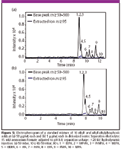
Figure 5
Conclusions
CE–MS-MS appears to be a powerful tool for the detection and identification of phosphonic acids in contaminated soil sample. Indeed, isomeric comigrating alkyl alkylphosphonic acids are differentiated by specific fragment ions. On the other hand, the identification of the isomeric alkylphosphonic acids IPA and PrPA was only provided by CE selectivity. All analytes can be detected easily at a level of 5 μg/g in soil samples thanks to the extraction treatment and at a level of 5 μg/mL in low-conductivity aqueous matrices, applying FASS. Sensitivity could be further improved in aqueous matrices and soil extracts by implementing other preconcentration techniques such as transient isotachophoresis.
Mélanie Lagarrigue*, Anne Bossée*, Arlette Bégos*, Anne Varenne†, Pierre Gareil†, Bruno Bellier*
*Analytical Chemistry Department, Centre d'Etudes du Bouchet,Vert-le-Petit, France
†Laboratory of Electrochemistry and Analytical Chemistry, UMR CNRS 7575, Ecole Nationale Supérieure de Chimie de Paris, Paris, France
Please direct correspondence to Pierre Gareil at pierre-gareil@enscp.fr.
References
(1) M. Mesilaakso, Ed., Chemical Weapons Convention Chemicals Analysis (Wiley, Chichester, 2005).
(2) E.W.J. Hooijschuur, C.E. Kientz, and U.A.Th. Brinkman, J. Chromatogr. A 982, 177–200 (2002).
(3) G.A. Pianetti, M. Taverna, A. Baillet, G. Mahuzier, and D. Baylocq-Ferrier, J. Chromatogr. 630, 371–377 (1993).
(4) S.A. Oehrle and P.C. Bossle, J. Chromatogr. A 692, 247–252 (1995).
(5) R.L. Cheicante, J.R. Stuff, and H. Dupont Durst, J. Chromatogr. A 711, (1995) 347.
(6) J.P. Mercier, Ph. Morin, M. Dreux, and A. Tambuté, J. Chromatogr. A 741, 279–285 (1996).
(7) J.P. Mercier, Ph. Morin, M. Dreux, and A. Tambuté, J. Chromatogr. A 779, 245–252 (1997).
(8) A.E.F. Nassar, S.V. Lucas, A.R. Jones, and L.D. Hoffland, Anal. Chem. 70, 1085–1091 (1998).
(9) A.E.F. Nassar, S.V. Lucas, C.A. Myler, A.R. Jones, M. Campisano, and L.D. Hoffland, Anal. Chem. 70, 3598–3604 (1998).
(10) J.E. Melanson, B.L.Y. Wong, C.A. Boulet, and C.A. Lucy, J. Chromatogr. A 920, 359–365 (2001).
(11) M. Urbanek, L. Krivankova, and P. Bocek, Electrophoresis 24, 466–485 (2003).
(12) E.D. Lee, W. Muck, J.D. Henion, and T.R. Covey, J.Chromatogr. 458, 313–321 (1988).
(13) J.A. Olivares, N.T. Nguyen, C.R. Yonker, and R.D. Smith, Anal. Chem. 59, 1230–1232 (1987).
(14) P. Cao and M. Moini, J. Amer. Soc. Mass Spectrom. 8, 561 (1997).
(15) Z. Kele, G. Ferenc, E. Klement, G.K. Toth, and T. Janaky, Rapid Commun. Mass Spectrom. 19, 881–885 (2005).
(16) J.L. Edwards, C.N. Chisolm, J.G. Shackman, and R.T. Kennedy, J. Chromatogr. A 1106, 80–88 (2006).
(17) A.P. Dahlin, M. Wetterhall, G. Liljegren, S.K. Bergstrom, P. Andren, L. Markides, and J. Bergquist, Analyst 130, 193–199 (2005).
(18) T. Wehr, LCGC 21(10), 974–982 (2003).
(19) R. Kostiainen, A.P. Bruins, and V.W.A. Häkkinen, J. Chromatogr. 634, 113–118 (1993).
(20) J.-P. Mercier, P. Chaimbault, P. Morin, M. Dreux, and A. Tambuté, J. Chromatogr. A 825, 71–80 (1998).
(21)C. Montauban, A. Bégos, and B. Bellier, Anal. Chem. 76, 2791–2797 (2004).
(22) M. Lagarrigue, A. Bossée, A. Bégos, A. Varenne, P. Gareil, and B. Bellier, J. Chromatogr. A 1137, 110–118 (2006).
(23) R. Chien and D.S. Burgi, J. Chromatogr. 559, 153–161 (1991).
(24) D.S. Burgi and R. Chien, Anal. Chem. 63, 2042–2047 (1991).

New Study Investigates Optimizing Extra-Column Band Broadening in Micro-flow Capillary LC
March 12th 2025Shimadzu Corporation and Vrije Universiteit Brussel researchers recently investigated how extra-column band broadening (ECBB) can be optimized in micro-flow capillary liquid chromatography.
A Review of the Latest Separation Science Research in PFAS Analysis
October 17th 2024This review aims to provide a summary of the most current analytical techniques and their applications in per- and polyfluoroalkyl substances (PFAS) research, contributing to the ongoing efforts to monitor and mitigate PFAS contamination.
Characterization of Product Related Variants in Therapeutic mAbs
October 15th 2024Navin Rauniyar and Xuemei Han of Tanvex Biopharma USA recently discussed how identifying product-related variants through characterization enables the recognition of impurities that compromise the quality and safety of drugs.

.png&w=3840&q=75)

.png&w=3840&q=75)



.png&w=3840&q=75)



.png&w=3840&q=75)






